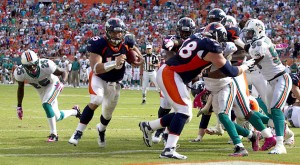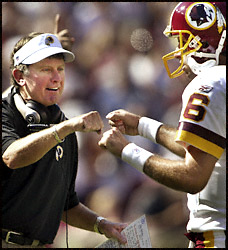Over that same period, there have been 81 times when a team scored a 4th-quarter touchdown when trailing by 15 points, cutting the lead to 9 (pending the extra point or two-point conversion). Only 5 of those teams went on to win the game, with the most recent occurrence happening last year when the Dolphins were Tebowed.
So when trailing by 15 in the 4th quarter, even after scoring a touchdown, your odds of winning aren’t very good. But of those 81 teams that scored a fourth-quarter touchdown to cut the lead to 9, only nine of them went for two after the touchdown. While the time remaining could play a part in the decision, the fact is most of the other 72 teams made a strategic error in kicking the extra point when trailing by 9 points.
The last [1]Technically, the last team to do this was the 2007 Jets. Trailing by 15 points with 3 seconds left, the Jets threw a touchdown as time expired, and then went for and converted a totally meaningless … Continue reading coach to recognize that going for two is the correct call? College football’s renegade, Steve Spurrier. In college football, the two-point conversion has been around since 1958, and in general, college football coaches are much more comfortable ‘going for 2’ than their NFL counterparts. [2]It’s worth noting that the American Football League had the 2-point conversion, and several teams there took advantage of the rule. In a 1965 game against the Oilers, the great Hank Stram … Continue reading
Against the 49ers on Sunday, with 6 minutes left in the final frame, Aaron Rodgers connected with James Jones to cut the lead to 30-21. At that point, attempting a two-point conversion is the obviously correct call, in an attempt to cut the lead to 7. I was disappointed but not surprised that Mike McCarthy decided to go for 1. But what did surprise me was seeing a number of smart people on twitter disagree with me that going for 2 is the right call. So I figured I’d devote a post to explaining why in this situation, it’s a no-brainer to go for two.The counterargument goes something along the lines of “just take the points, that way it is a one-score game.” Essentially, people are afraid of missing the two-point attempt and trailing by 9 points. But it’s not a one-score game. Trailing by 8 isn’t a one-score game if you are going to fail on your two-point try. And there’s no reason to think your odds of converting a 2-point attempt are higher when trailing by 2 than by 9. Trailing by 8 is a 1.5-possiession game; half the time it is a 1-possession game, and half the time it is a 2-possesion game. To simply put your head in the sand and say “I don’t wanna know!!” may keep hope alive longer but it lowers your odds of winning.
There are many hypothetical scenarios where it would really matter to know whether you are going to be successful on your two-point conversion. Say you’re down 15 with 7 minutes to go and score a touchdown. You stop the other team, get the ball back, and drive to their 25. You’re out of timeouts and there are 3 minutes to go. It’s 4th and 10. At that point, wouldn’t your decision to go for it change if you were down by 9 instead of 8? Down 8, teams go for it because they consider it a one-score game. But if you’re going to miss the 2-point conversion, now you’d want to kick the field goal.
Knowledge is power. You need to get a two-point conversion at some point, and knowing whether you’re going to convert is important information. There is no reasonable reason not to go for 2 after your first touchdown. Yes, missing out on the two-point conversion earlier could be demoralizing. But what would you call missing out on a two-point conversion with 5 seconds left when trailing by 2?
There is a reason why coaches fail to go for 2 in this situation, and why smart fans also think it’s correct to take the safe points. It’s because they’re focused on keeping their hope alive as long as possible. As my friend Brian Burke once wrote, “coaches do not coach to maximize their team’s chances of winning. My theory is coaches are delaying elimination until the latest point in the game—that is, trying to “stay in the game” for as long as possible.”
By kicking the extra point, you (falsely) believe you’re staying in the game for longer. A missed two point conversion attempt with 8 seconds left means you had hope for 59 minutes and 52 seconds. Missing the two-point conversion earlier kills your hope, knowing that it’s now a two-score game. But the goal of a coach should be to maximize his team’s odds of winning, not to make his team’s players and fans feel warm and fuzzy. Missing the 2-point attempt at any point is going to drastically lower your team’s odds of winning. It’s true that if you score a touchdown to cut the lead to 9, and then miss the 2-point attempt, your odds of winning have decreased significantly. But it’s not the going for 2 early and failing that lowers your odds of winning, it’s simply missing the 2 point conversion that lowers your odds.
If you are going to convert the 2-point attempt, it doesn’t matter all that much whether you go for it early or late. If you’re going to miss it, going for it earlier significantly improves your odds of pulling off a miraculous comeback, precisely because you’re got almost no chance if you miss it late. If you are going to miss your two-point attempt, you’re in much worse shape finding that out with 1 minute left than with 7 minutes left. Knowledge is power, and coaches that pull a McCarthy are playing with a weaker hand. To state that you don’t want to go for 2 down by 9 because if you miss it is no longer a two-score game makes no sense, because if you are going to miss the 2-point conversion an 8-point lead is already a two-score game.
Note that how the Packers game unfolded presents a good example of why you want to go for two early. Green Bay kicked off to San Francisco, and eventually stopped the 49ers with just under 4 minutes to go. At that point, the Packers took their time driving down the field, reaching only the 49ers’ 45-yard line with 45 seconds to go. From there, Green Bay’s 4th down play was unsuccessful, but had the drive resulted in a score, there would have likely been only a few seconds remaining in the game. At that point, a missed two point conversion ends the game. Had the Packers gone for two and missed earlier, they would have played with more urgency on their final drive, and at least would have a chance for an onside kick and time to drive into field goal range for the win.
In college football, in overtime, each team gets one possession at the opponent’s 25-yard line. It is obvious that playing defense first is advantageous, and every college team elects to play defense first if they win the overtime coin toss. Knowing whether you need 3 or 7 points to win (or tie) is valuable information. We have exactly the same situation going on here, but the desire to keep hope alive prevents coaches from acting rationally.
References
| ↑1 | Technically, the last team to do this was the 2007 Jets. Trailing by 15 points with 3 seconds left, the Jets threw a touchdown as time expired, and then went for and converted a totally meaningless two-point conversion. |
|---|---|
| ↑2 | It’s worth noting that the American Football League had the 2-point conversion, and several teams there took advantage of the rule. In a 1965 game against the Oilers, the great Hank Stram recognized the benefit in going for two earlier rather than later. Trailing 35-20 late in the game, Hank Stram had the Chiefs go for two after a Len Dawson touchdown pass to Curtis McClinton. Kansas City converted, cutting the lead to 35-28. On their next drive, Dawson hit Otis Taylor for a 9-yard score, and Stram really upped the ante then. Calling a Pete Beathard run, the Chiefs converted and took a 36-35 lead with just over a minute to go. Unfortunately for Stram, the Chiefs went into an ultra-prevent defense, and allowed the Oilers to drive down and kick a game-winning field goal. |


